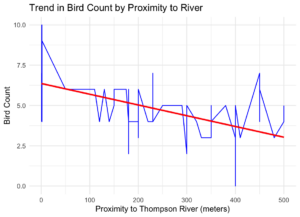In my quest to understand the intricate dynamics of biodiversity, I often turn to natural habitats like parks and riversides, where various species thrive in their natural environments. Riverside Park in Kamloops, British Columbia, offers a rich tapestry of habitats, from the tranquil Thompson Riverbank to the bustling Grassland and Flowerbed areas. In this blog post, I delve into the fascinating world of bird diversity in Riverside Park, shedding light on my recent data collection efforts and the insights gained.
My journey began with meticulous data collection across three distinct habitats: Thompson Riverbank, Riverside Park Entry, and Grassland and Flowerbed. Over several days, I measured the distances from each site to the Thompson River, spending 10 minutes observing and recording bird species in each habitat. I meticulously noted the species encountered, their abundance, and their proximity to the Thompson River.
Utilizing the R studio, I conducted a rigorous analysis of bird count data. Employing the ggplot2 package, I visualized the relationship between bird count and proximity to the Thompson River using a line graph. Additionally, I employed the lm function to fit a linear regression model to the data, which revealed a statistically significant negative relationship between bird count and proximity to the river. As proximity to the river increased, bird count tended to decrease, challenging my initial hypotheses and highlighting the complex dynamics of avian communities in Riverside Park.
While my hypothesis suggested a positive correlation between bird diversity and proximity to water sources, the magnitude of the effect surprised us. The Thompson Riverbank emerged as a hotspot for avian activity, with its lush vegetation and abundant resources providing a haven for a diverse array of bird species. This unexpected discovery opens avenues for further exploration, prompting us to delve deeper into the ecological drivers shaping bird communities in Riverside Park.
As I conclude my journey through Riverside Park, I am reminded of the intricate web of life that surrounds us. My data-driven exploration of bird diversity serves as a testament to the wonders of nature and the endless possibilities for scientific inquiry. Through collaborative efforts and a commitment to understanding our natural world, I continue to unravel the mysteries of biodiversity, one bird at a time.

figure1. This negative linear graph represents the relationship between bird count and proximity to the Thompson River.